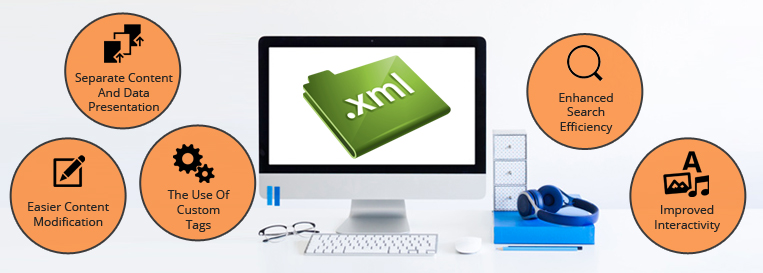
Extensible Markup Language (XML) has emerged as the most favored language for data conversions. It structures the document in a reader-friendly manner while creating systematic formats that contribute in easy and reliable sharing of the structured data through different online and offline networks.
Derived from Standard Generalized Markup Language (SGML), XML is a great fit for creating several document formats like Atom, RSS, SOAP, and XHTML. XML, although is not the only language for markup, it still has a comparatively wider application because of its versatile features. Considering its dynamic nature and a slew of benefits it offers, many organizations outsource XML Conversion Services for publications, documents, business data, ebooks etc.
5 Primary Features That Make XML An Unparalleled Data Conversion Language
-
The Use Of Custom Tags
With XML, the user can have the option of defining custom tags and new elements, their occurrence order and their display as per the distinct requirements. You can’t have this feature in HTML, as it only offers fixed tags and tag semantics.
-
Separate Content And Data Presentation
XML conversion helps to store data in separate XML files which assists in segregating the content from the HTML/CSS used for display and layout. This aids in managing the style and display of content through XSL stylesheets. You can even modify the look of a document or webpage without any interference from the content of the document.
-
Easier Content Modification
Having separate XML files for data storage allows easier content modification. You don’t need to make any changes to the display HTML code to modify data. Whereas in HTML, to display dynamic data, one needs to put in extensive efforts each time you want to make any change to the data.
-
Enhanced Search Efficiency
XML converts data into a machine-readable format which can also be easily read by humans. The XML documents are structured to not only enable element by element aggregation and comparison of documents but also to enable the element structure and tags providing context information. This facilitates intelligent data mining and improved search efficiency.
-
Improved Interactivity
XML documents are compatible with various multimedia elements, allowing to include images, videos, and audio files. One can even add active components like ActiveX or Java applets. Publishers, generally make the best use of this feature while converting their interactive digital books to XML.
Apart from the above-mentioned features, XML has various other aspects that contribute to its versatility. Features such as the simplification of data transport and facility of developing new languages surely position XML over other data conversion languages like HTML. It further emphasizes why organizations need to Outsource XML Conversion Services for their data files.
Considering the wide applicability of XML and its responsive features, you must be thinking to collaborate with an experienced XML conversion service provider. So, drop a mail to info@suntecdigital.com to know how you can leverage the power of this versatile format.

 info@suntecdigital.com
info@suntecdigital.com